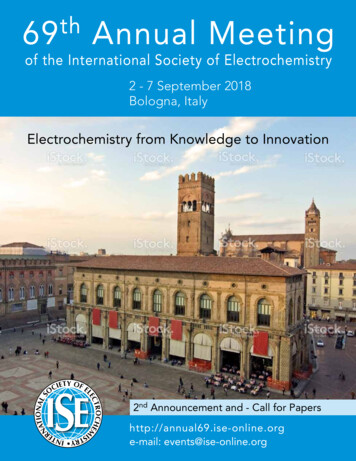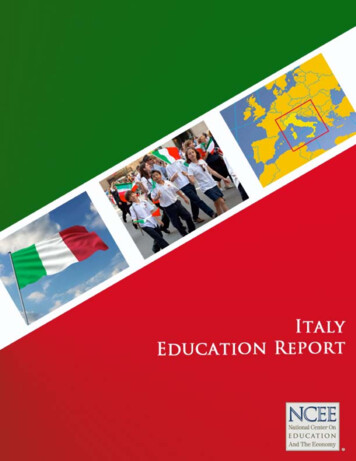
Transcription
An Overview of Italy’s Education SystemNational Center on Education and the EconomyNew Commission on the Skills of the American WorkforceJuly 2005 National Center on Education and the Economy, 2006
An Overview of Italy’s Education SystemFrom 1996 through 2001, Italy enacted a series of new laws focused on the familyand the role of government uncharacteristic for a country that has long avoidedexplicit family policy. For years, Italian social policy was directed toward certaincategories of families and family members, in particular, children, pregnantwomen, poor families, and families with a handicapped child. The new lawsprovide increased income support for less well-off families with children, newparental leave, and a comprehensive reorganization of social services and socialassistance.Italy's history of a strong Catholic tradition coupled with a weak nationalgovernment, on the one hand, and strong regional governments coupled withan industrialized and affluent north on the other resulted in a limited andfragmented welfare state. As Italy follows the trends in lower birthrates andhigher female labor force participation rates characteristic of its Europeanneighbors, it too is motivated to develop stronger social policies, especiallyaround the family.Traditional family roles and structures continue to dominate Italy, as well as theregional differences between the more urban, economically developed north andrural, agricultural south that have long existed. Women continue to haveprimary responsibility for children, and adult children continue to bear primaryresponsibility for caring for their aging parents. The elderly are living longerand adult children tend to remain at home with their parents until marriagewhich like other industrialized countries, is increasingly delayed. Although thelabor force participation rate of Italian women at 46.8 percent is well-below theEU and OECD averages of just over 60 percent, the rate is higher in Italy than ithas been in the past and calling for reorganization of family time and roles.Of growing concern and an impetus for policy change, is Italy's very low fertilityrate - at 1.24 it is the lowest in the EU, coupled with delayed childbearing.Concern too, that the economic situation affects family formation, spurned anincrease in both tax deductions and allowances for families, as well the provisionof economic benefits to young families with children for meeting housing needs.A recent secondary analysis of data from the 1994 European CommunityHousehold Panel Survey revealed that, compared to 75% of young Danes whohad left their families of origin between the ages of 21 and 25, only 7% of theirItalian contemporaries had taken this step. Some 28% of all women between 21and 25 were already mothers in Sweden and the United Kingdom, as opposed toonly 12% in Italy. In the United Kingdom, half of all young people had joined thejob market by age 19; while in Italy, entry to the job market tended to happenfive years later with half of all young Italians still without a job after age 24.Family poverty remains high in Italy (12.3% in 2000). The gap between theincidence of poverty in the North and in the South grew steadily. In 2000, thepercentage of poor families by geographic division was the following: 22% in theNorth, 15.3% in the Centre and 62.7% in the South, where more than one familyin five (23.6%) lives in conditions of relative poverty (as opposed to 5.7% in the National Center on Education and the Economy, 20062
North and 9.7% in the Centre). Public assistance given to families is scarce, as ishelp given via services. Together with the UK, Italy is the country with thehighest rate of child and youth poverty.Italy is a parliamentary republic, a partly decentralized system. Education policymaking is shared between the national government which has responsibility forfunding, school curricula, and quality control and the Regions responsible foreducation delivery, in particular for vocational education and training (seewww.istruzione.it). During 2002, public debate was focused on the proposedmajor reform of the education system. The legislation, which was passed byParliament early in 2003, affects the structure of schooling, increases theautonomy of the individual schools, and decentralizes political andadministrative decision making to the regional level (seewww.istruzione.it/mpi/progettoscuola). The law extends the right to educationand vocational training up to the age of 18 years. There are now two educationlevels: primary school (5 years) and lower secondary school (3 years); the secondlevel provides two options: the “Liceo”, or general education (5 years), withdirect access to university, and the system of vocational education and training (4years) that awards a vocational qualification and allows, with a supplementaryone-year course, for enrolment in university. Parallel to this legislation, aNational Institute for the Evaluation of the Education System was established. In2002 it conducted a national survey aimed at developing instruments for theregular assessment of the effectiveness of educational provision and the qualityof its outputs. (See www.invalsi.it).THE ITALIAN EDUCATION SYSTEMThe SystemUp to Age 3: Day nursery (Nidi d'infanzia)Ages 3 to 6: Nursery school (Scuola materna)Ages 6 to 10: Elementary school (Scuola elementare)Ages 11 to 14: Middle school (Scuola media)Ages 15 to 19: High school/Secondary school (Scuola secondaria di II grado):High School/Secondary School Courses of Study:Classical (Classica)Scientific (Scientifica)Technical (Tecnica)Vocational (Professionale)Higher education (4 to 6 years’ duration): University (Università)Early Childhood Education and Care (ECEC)Almost 95 percent of Italian children aged 3 to 6 are enrolled in preschoolprograms, which is among the highest rates of enrollment in the EuropeanUnion. Italy's ECEC programs are divided by age and follow a pattern fairlysimilar to that in France and Belgium. Compulsory primary school begins at age6. National Center on Education and the Economy, 20063
Scuola Materna (Preschool). Like the French Ecole Maternelle, the ScuoleMaterna is the Italian preschool program serving children aged 3-6, under theauspices of the Ministry of Education, financed largely by the nationalgovernment, free for the core school day and voluntary. About 96 percent ofthe cohort is enrolled. The program began as in several other countries, morethan a century ago, as a private philanthropic activity carried out under religiousauspices. There was little further development before 1968, when nationallegislation was enacted, assigning responsibility for the establishment ofpreschools to the Ministry of Education. With national funding, the initialpriorities were for economically depressed areas and rapidly growing urbanareas; but the 1970s saw an explosion of provision along with an acceleration offemale labor force participation. The Materna are 10-month programs openfrom about 8:30 am to 4:30, 5:00, or 6:00pm, depending on location and program.One such program in Reggio Emilia is world renowned for its quality andcreativity.Italian leaders in the field account for the explosion in demand for publicpreschools to five factors: (a) increasing awareness of the value of a groupexperience for a child's social development and a child's right to have such anexperience; (b) the recognition of the value of preschool as preparation forprimary school; (c) smaller families and parents concern about the growingisolation of young children (e) the declining availability of qualified staff inreligious schools; and (e) parental belief that state schools were of higher qualityand more convenient because of their longer hours. Almost 60 percent of thechildren attend public preschools while only 19 percent are in church programsand 10 percent in private secular programs. About 1/3rd of the facilities arereligious while almost all the remainder are public.Asilo Nido (Child Care Centers). The Asilo Nido is the publicly funded andlargely publicly operated child care program serving children aged three monthsto three years, open 11 months of the year, and charging income-related fees.The program emerged out of the same history and institutions as the scuolamaterne. However, national legislation enacted in 1971 gave all mothers theright to use these programs for the under threes, but gave working motherspriority for places; other priorities now are children of lone mothers, poormothers, and handicapped children. Yet despite these criteria for eligibility, mostchildren who attend are from middle and upper class families.The law decreed that the national government should play an active role infunding these facilities, employers should contribute 1 percent of payroll taxes tosupport them, but that regional and local governments should haveresponsibility for their operation. Today, regional and local governments are theresponsible agencies for funding and operating the program.The Asilo Nido began first as a social service, then became a support service forworking women, and only recently has begun to be viewed as an importantdevelopmental experience for children generally. It is still not viewed in the sameway as the Scuola Materne which is now universally viewed as an essentialsocialization and educational experience for all children. National Center on Education and the Economy, 20064
The Asili Nidi cover the full workday and are often open 11 hours a day from7:30 a.m. to 6:30 p.m. They are designed to serve children from three months ofage, but children usually begin at 9 months or 1 year, when the parental leaveends. Typically, centers serve from 30 to 60 children. Coverage is modest,nationally, at about 6 percent of the age group, but in the north in some regionssuch as Emilia-Romagna, coverage may reach 30 percent. All centers are publicand almost all are operated under municipal auspices. Quality variesenormously, but is excellent in certain parts of the north. There is little or nofamily day care and most children of working mothers are still cared for bydomestic servants who provide in-home care.The Emilia-Romagna region has been in the forefront of these developments, asit has with regard to Scuola Materna, and has established an innovative systemof infant and toddler care under the auspices of the public education system.Given the shortage of places, and the conviction that a group experience isimportant even for the very young, this region has developed part-day and partweek programs serving all caregivers of very young children, both at-homeparents, grandparents, and "nannies".According to the OECD Thematic Review, Starting Strong, a proposal has beensubmitted to transfer responsibility for the 0-3s from regions and municipalitiesto the Ministry of Education. There is also an effort to improve the sharing ofknowledge and expertise between the northern and southern municipalities withregard to developing ECEC programs. Further enhancements include increasingstaff training and skills, such as requiring teachers and coordinators to have auniversity degree. Other contact staff will be required to hold a 3-year, tertiarydiploma.Elementary and Secondary EducationThe Current SystemThe difference between elementary and secondary education in Italy is less clearthan in the US since the Italian school system is currently divided into threelevels. The first, scuola elementare, begins at age six and lasts for five years.Upon completion, students move on to the scuola media. This is mostcomparable to the three years of study in American middle schools. If thestudents have performed satisfactorily, they receive a Diploma di Licenza diScuola Media, with the opportunity to continue their education at a scuolasuperiore after age 14. Mandatory schooling ends with graduation from a scuolamedia.The length of study at a scuola superiore is four or five years, depending on thetype of school and program in which the student is enrolled. Students maychoose among different high schools, known as licei, for specific courses of studyin the arts, sciences, linguistics, and what is known as a classical education. Otherinstitutes (istituti) offer students preparation for teaching at the elementaryschool level and for technical, industrial, and commercial careers. National Center on Education and the Economy, 20065
After completion of their chosen courses of study in a scuola superiore, studentsmust pass a state examination to earn a Diploma di Maturità and the ability tocontinue their studies at a university.Changes UnderwayThe new education system in Italy will raise the age for compulsory schoolattendance from 14 to 16. The extra two-year period (biennio) will involve acourse of general studies that will precede three years (triennio) of optionalspecialized study at a liceo. These new study options will be offered to betterprepare students to attend a university.Higher EducationThe Current SystemUniversities in Italy focus mainly on two tasks—teaching and research. Thisapproach provides considerable academic autonomy and freedom for studentsto pursue courses of study. Educating over 1.25 million students, the four typesof Italian institutions are: 42 state universities 6 private universities 3 technical universities, Politecnici 12 university institutes with special statusRecent investments in the university system have led to the creation of four newuniversities and substantial upgrading of the existing ones through additionssuch as language laboratories and multimedia centers.Major Italian universities include those in Bologna (the world’s oldest, founded in1088), Turin, Rome, Florence, Ferrara, Naples, Modena, and many others.The CoursesUniversities offer four main courses of study:1. University Diploma, Diploma universitario: A fairly new addition to Italianhigher education, the Diploma universitario helps to synthesize Italian educationwith the education systems of the rest of Europe. The internationally-recognizedbaccalaureate courses last two to three years and are specialized within certainvocations. These courses have not yet been developed in all fields of study, soadmission is competitive.2. Bachelor of Arts/Science, Diploma di Laurea: The Laurea is a more in-depthcourse of study than the University diploma. It takes four to six years tocomplete, and students who choose this level of education are able to create theirown study plans (piani di studi), subject to approval by the university.Qualification for the Diploma di Laurea is achieved through numerous examsand a thesis (tesi).3. Research Doctorate, Dottorato di Ricerca: This level of education is considered National Center on Education and the Economy, 20066
postgraduate. It is characterized by extensive scientific research and an annualreport for each of the three to four years of study. A student obtains a doctoratethrough documentation of research and a final dissertation. Admission to aDottorato di Ricerca program is competitive and limited to only those who havecompleted the Laurea or a European equivalent.4. Diploma of Specialization, Diploma di Specializzazione: This is also postgraduate education. Lasting two to three years, it includes practical vocationalexperience in a specific career and requires a final examination and a thesis.Changes UnderwayCurrent reforms in the University system reflect a general restructuring of thehigher education process.Italian Universities will be asked to adopt a ‘three-cycle system’:1. The first cycle will be three years long and focused on a curriculum ofprofessional training. It will culminate in a first-level degree (Laurea).2. The second cycle will last two years and will end with awarding of a LaureaSpecializzata.3. The third cycle, lasting between one and two years, will earn a student either adoctorate or a postgraduate specialized degree.All courses must be based on the European Credit Transfer System (ECTS).The Italian government intended for these changes to be in place by the end ofthe 2001 academic year. However, the managerial autonomy that Italianuniversities have traditionally enjoyed and continue to enjoy - politically,organizationally, and operationally - is at variance with centrally-managedchange. National Center on Education and the Economy, 20067
only 12% in Italy. In the United Kingdom, half of all young people had joined the job market by age 19; while in Italy, entry to the job market tended to happen five years later with half of all young Italians still without a job after age 24. Family poverty remains high in Italy (12.3% in 2000). The gap between the
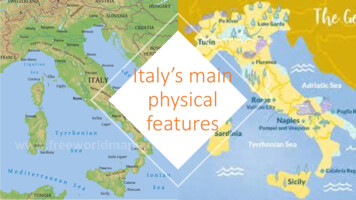
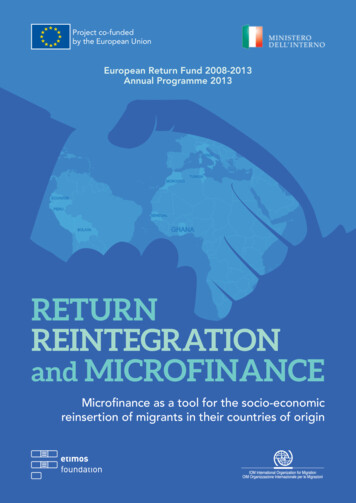
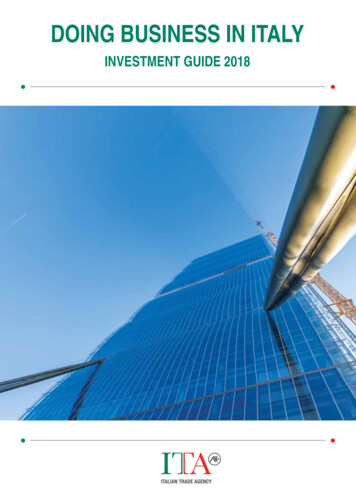

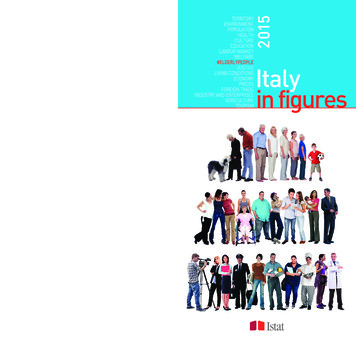
![The GIANO-TNG spectrometer [6269-46]](/img/1/spie-6269-46.jpg)

